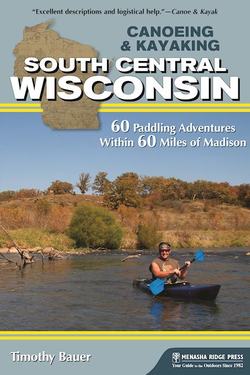Читать книгу Canoeing & Kayaking South Central Wisconsin - Timothy Bauer - Страница 13
На сайте Литреса книга снята с продажи.
What Is and Isn’t Included
ОглавлениеJust as no one part represents the whole, the story of Wisconsin’s streams is told big and wide as well as small and meandering. I have presented here the bustling Dells, together with the solitude of the Montello River and the literal circus and calliope of the Baraboo River, alongside the quiet rustle of Badfish Creek.
This book encompasses some 11,000 square miles in territory. More than 560 miles of rivers and lakes are covered here, not including another 240 that I personally paddled but did not pass muster.
In selecting which trips to profile for this guide, I have tried to be as inclusive as possible while advocating for those places about which there is not already plenty of information. But I decided it would be quixotic to the point of preposterous not to include certain popular trips, too, however well known and elsewhere covered. (I will be the first to wax poetic about the incomparable Wisconsin Dells. In much the same way that Todd Snider still loves to sing “Beer Run” at every concert so many years later and after a million times performed, I will defend paddling down the Dells to my dying breath. The area now caters to tourists and has become distractingly tacky, yet there simply is nowhere else in the state with such exquisite riverside geology.) Where I have recapitulated certain sections of rivers that are covered in other guides, I have furnished new information or added my own twist. Even seasoned veterans of our rivers can find something new to discover in this book.
Another of my guiding principles in sharing the trips featured here has been a sense of balance: Do the pros outweigh the cons? Some trips in this book require putting up with an impediment or two. Ducking underneath low-hanging branches or bridges and riding over the occasional log is par for the course. It is my belief that portaging, while seldom welcome, is part of the paddling experience. When deadfall and logjams are a likely albeit infrequent occurrence on a trip, I will point them out. But I have opted not to include trips whose nuisances and obstructions are so prominent as to undermine the whole reason for being outdoors in the first place. Mill Creek in Iowa County and Honey Creek in Sauk County, for example, are both rich in potential but poor in reward due to their many frustrations.
Just as I sought a departure from the conventional wisdom of most paddling guidebooks by featuring lesser-touted trips, I have also distinguished this guide by including lakes. (Of the five lake trips in the book, four are on lakes that prohibit all but electric boat motors; Red Cedar Lake is in a designated state natural area where all motors are prohibited.) I prefer moving rivers to staid lakes, but there’s a lot to like in a lake. A lake is a great place to get one’s feet wet in a canoe or kayak. Plus, there are no shuttling logistics to work out when paddling lakes, there are typically no obstacles, and there is something downright majestic about letting yourself drift on a calm lake at sunrise or sunset. But moving water is a dynamic all its own, so it’s wise to learn some basics of boat control, even on still water.
While lakes are pretty lazy, on a windy day they are suddenly awoken from their slumber and aroused, heaving waves one after another. Here in the Upper Midwest, the closest proxy to sea kayaking is the Great Lakes; alas, neither Lake Michigan nor Lake Superior falls within a 60-mile range of Madison. But when the wind is whipping at 20 miles per hour and up, splashy whitecaps as high as 2 feet can form on Lakes Koshkonong and Mendota, the largest two lakes in south central Wisconsin. Bobbing up and down and riding these modest waves make for a fun rodeo-type outing, provided that you have the right gear and know how to roll a kayak or perform a wet entry.
As for the streams featured in this book, they are purposefully varied. They range from 15 feet to more than 500 feet wide; some are only a few inches deep, others seemingly infinite. There are streams with gradients of 10 feet per mile (fpm) or more, with the effect of frisky riffles and fun rapids, and those that give tortoises a run for their money. There are streams that meander and those so straight you can set a rudder on automatic pilot. Some streams can be run all year long, and some are more fickle, requiring a delicate balance between just enough rain to run without scraping and so much rain that the stream becomes pushy and unsafe. Some of these trips are entirely urban (but still highly desirable), such as Turtle Creek in Beloit, while others are a true getaway, such as the White River in Neshkoro. Regardless, most of the trips here begin and/or end near a town for ease of access and practicality.
